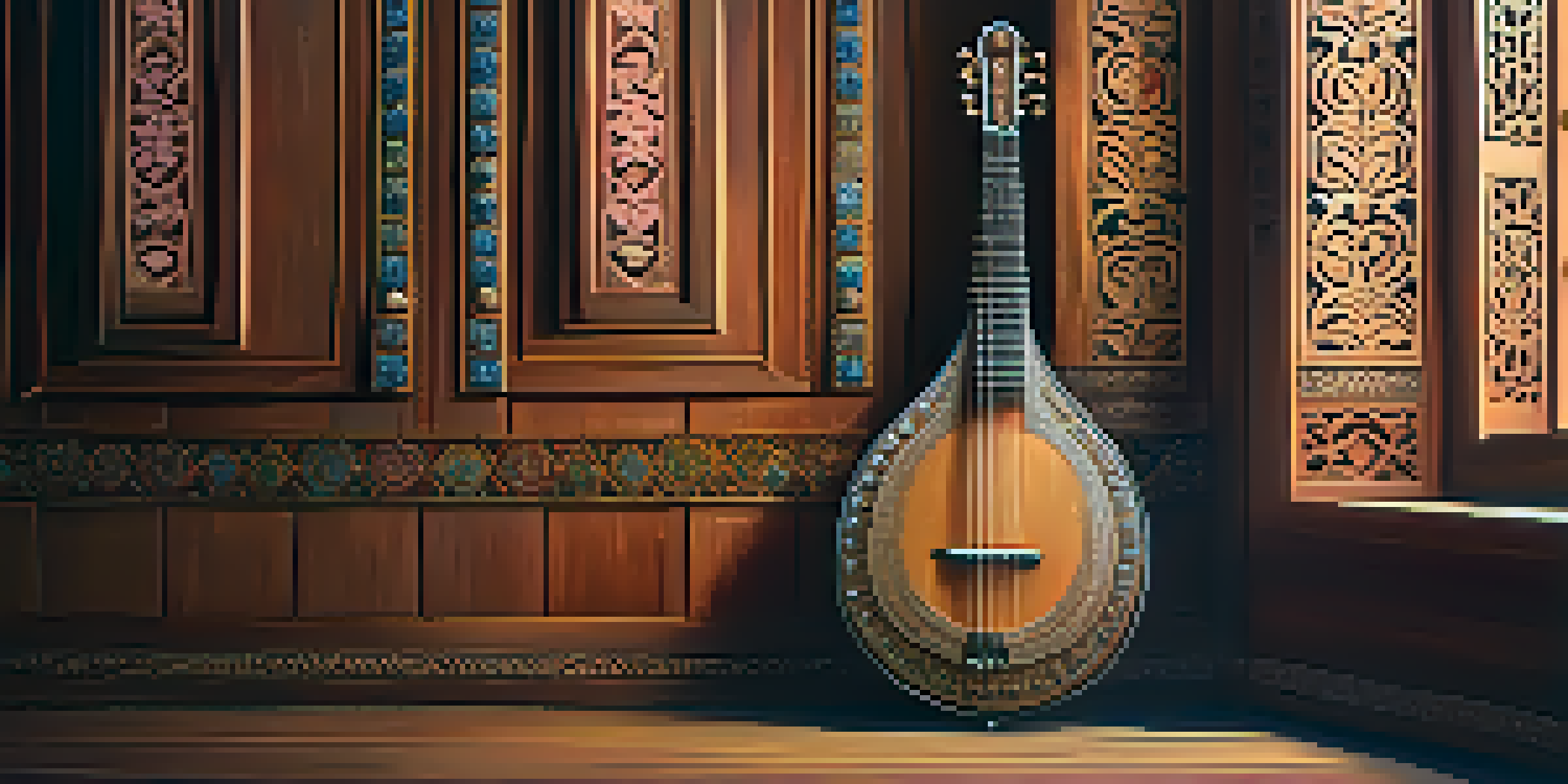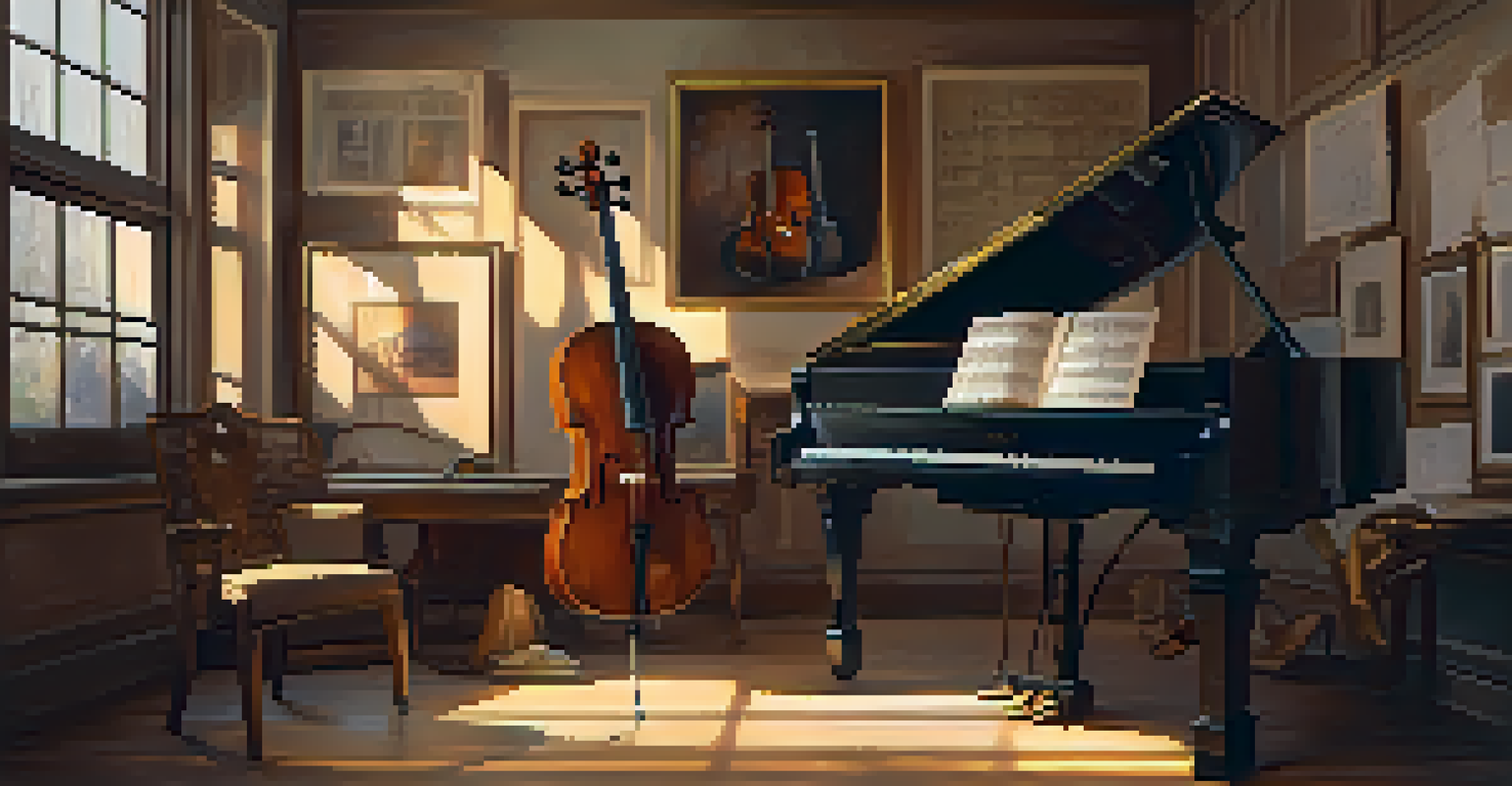The Influence of Traditional Instruments on Modern Music

The Roots of Modern Music: A Brief Overview
Music has always been a reflection of culture, and traditional instruments serve as the foundation for many modern genres. From the strumming of a guitar to the melodic lines of a flute, these instruments tell stories that resonate through time. They hold the essence of their origins, influencing new compositions and arrangements in today's music landscape.
Music is the universal language of mankind.
Understanding the historical context of traditional instruments helps us appreciate their role in contemporary music. Genres like jazz, blues, and even pop borrow elements from folk traditions, creating a rich tapestry of sounds. This fusion has allowed artists to experiment, pushing the boundaries of creativity while honoring their musical heritage.
In essence, modern music often acts as a bridge between the past and the present. By incorporating traditional instruments, musicians can evoke nostalgia and connect with audiences on a deeper level. This interplay highlights the importance of preserving cultural sounds while innovating for future generations.
Traditional Instruments in Popular Genres
From hip-hop to indie rock, traditional instruments are making waves across various genres. For instance, the use of the sitar in popular music has been famously popularized by artists like The Beatles and more recently by contemporary musicians. This not only adds unique tonal qualities but also introduces listeners to different cultural sounds.

In country music, the banjo and fiddle play crucial roles, infusing tracks with a sense of authenticity and storytelling. Artists like Sturgill Simpson and Kacey Musgraves seamlessly integrate these instruments, showcasing how traditional sounds can enhance modern songwriting. This connection enriches the genre and keeps its roots alive.
Traditional Instruments Shape Modern Music
Traditional instruments serve as a vital foundation for contemporary genres, enriching the music landscape with cultural narratives.
Moreover, pop music has seen a resurgence of traditional sounds, with artists experimenting with instruments like the accordion or the ukulele. These choices often create catchy hooks that resonate with a diverse audience. The blending of old and new keeps the music fresh and exciting, reflecting the ever-evolving nature of the industry.
The Cultural Significance of Traditional Sounds
Traditional instruments are not just tools for making music; they carry significant cultural narratives and histories. Each instrument tells a story of its origin, reflecting the values and experiences of the communities that created them. This cultural significance is often woven into the fabric of modern music, creating layers of meaning.
The essence of music is a reflection of culture and tradition.
For example, the djembe, a West African drum, has found its way into various genres like rock and electronic music. Its rhythmic complexity not only adds a vibrant sound but also pays homage to its cultural roots. By incorporating such instruments, artists can honor the traditions while introducing them to new audiences.
This cultural exchange fosters appreciation and dialogue between different musical traditions. As modern musicians embrace these sounds, they contribute to a broader understanding of cultural diversity. It’s a beautiful way of celebrating heritage while pushing the boundaries of creativity.
Innovations in Instrumentation and Technology
The evolution of technology has transformed how traditional instruments are perceived and utilized in modern music. Digital tools allow musicians to manipulate sounds in ways that were once unimaginable. For instance, the ability to electronically amplify a traditional instrument can enhance its reach and versatility.
Moreover, software like music production programs enables artists to blend live recordings of traditional instruments with synthesized sounds. This marriage of old and new results in innovative compositions that resonate with today’s audiences. The creativity that emerges from this process is a testament to the adaptability of music.
Cultural Exchange Enhances Music Diversity
The integration of traditional sounds allows for a beautiful dialogue between different cultures, promoting appreciation and understanding.
As technology continues to advance, traditional instruments are likely to evolve, finding new roles within modern music. This constant adaptation ensures that these instruments remain relevant, allowing musicians to express their artistry in diverse and exciting ways.
Case Studies: Artists Blending Tradition with Modernity
Many contemporary artists have successfully melded traditional instruments with modern styles, creating unique sounds that captivate audiences. One notable example is the musician Yo-Yo Ma, who blends classical cello with world music influences, showcasing the versatility of his instrument. His collaborative projects highlight how traditional instruments can thrive in varied musical landscapes.
Another artist, Hozier, incorporates traditional Irish influences into his music, enriching his sound with elements like the uilleann pipes. By doing so, he creates a distinct sonic identity that resonates with listeners globally. This blend of tradition and modernity not only showcases his heritage but also introduces it to a broader audience.
These case studies illustrate a growing trend in the music industry, where artists are intentionally drawing from their cultural roots. This practice not only diversifies the musical landscape but also keeps the stories and sounds of traditional instruments alive.
The Global Influence of Traditional Music
As the world becomes more interconnected, the influence of traditional music spans geographical boundaries. Artists from different cultures are increasingly collaborating, creating fusion genres that blend traditional elements with modern styles. This global exchange enriches the music scene and introduces audiences to diverse sounds.
For instance, the rise of genres like reggaeton combines Latin rhythms with hip-hop and electronic music, reflecting cultural influences from around the world. Traditional instruments like the cuatro or marimba add depth and authenticity to these new sounds, demonstrating the power of cultural fusion.
Preservation Ensures Musical Heritage
Efforts to preserve traditional instruments and their associated skills are essential for maintaining cultural heritage and inspiring future generations.
These global influences serve as a reminder of music's universal language. By integrating traditional instruments into modern compositions, artists create a dialogue that transcends borders, fostering understanding and appreciation across cultures.
Preserving Traditional Instruments for Future Generations
With the rapid evolution of music, it’s essential to focus on preserving traditional instruments and the skills associated with them. This preservation not only safeguards cultural heritage but also ensures that future generations can experience and learn from these sounds. Various organizations and initiatives are dedicated to teaching traditional music and instrument-making.
Workshops and community programs aim to engage young musicians, encouraging them to explore their cultural roots. By fostering interest in traditional instruments, these programs help maintain the relevance of these sounds in modern music. This grassroots effort is crucial for sustaining the legacy of traditional music.

Ultimately, the preservation of traditional instruments allows for a vibrant musical landscape where both old and new can coexist. By valuing these sounds, we not only honor the past but also pave the way for innovative expressions of culture in the future.